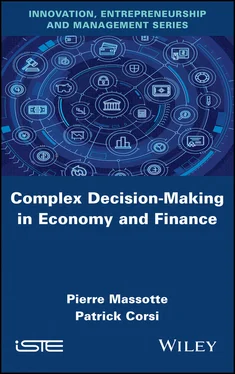1 ...7 8 9 11 12 13 ...19
1.3.3. The smoothing property of chaotic characteristics
In this section, we propose to make the link between Laplacian determinism, according to which “ nothing new can happen unless it is already contained in the initial conditions ” and deterministic chaos which stipulates that very simple systems give rise to very complicated trajectories and unpredictable evolutions. In the case at hand, the problem is whether a chaotic or turbulent phenomenon at a microscopic level generates a coherent and stable state at a higher level.
To explain this fact, we recall the work of E. Lorenz who highlighted the phenomenon of exponential sensitivity compared to initial conditions: the size of the disturbances doubles each time the time spent increases by a given unit [ROB 01]. Thus, two initially neighboring points on a phase diagram have rapidly separating trajectories; they diverge and their behavior over time is different. In the same way, Hadamard has shown that the movement of a marble on a negative curve surface is exponentially unstable (horse saddle problem). It is therefore impossible to calculate the trajectory of the ball after a very short time. This problem can be found in a billiards game as well as in the perfect fluid model: the problem of hydrodynamic instability is reduced to that of calculating a curvature. This problem is also that of the SIC (Sensitivity to Initial Conditions) which has led us to rethink the world in terms of “deterministic chaos” or “fractal chaos”, with the famous example of the butterfly effect that illustrates the complexity of systems with its notions of unpredictability.
But what is the problem here? When modeling a simple system, new statistical phenomena that may arise when changing scale (e.g. from micro to meso level) and moving from a small to a larger number of degrees of freedom are generally not taken into account. To illustrate this problem with Boltzmann’s experience:
– if we study the movement of a gas composed of a few molecules in a closed elastic enclosure, we will be able to put the system into an equation; however, due to elastic collisions, we join the problem previously described and we cannot predict the trajectories of each molecule in the long term, therefore the overall evolution of the system;
– on the contrary, if we focus on global and “integrated” variables, such as the average value of gas density or the average value of gas pressure, we know that these variables are calculable – they are determined statistically – and we know how to predict that the pressure, for example, will remain uniform throughout the enclosure and will increase by this or that value according to temperature.
Thus, between the microscopic and macroscopic levels, the same variables are not used. In the first case, they are the coordinates of a trajectory. In the other case, they are observable global variables. We generally do not know how to “move” from the microscopic to the macroscopic level, although the links are strong and underlying: each level has its own geometry (classical geometry and fractal geometry).
Thus, in an industrial system, when we ask to determine, on the basis of local objectives and behaviors, the global objectives and behaviors of a system, we sometimes respond, due to lack of experience: “ It is a complex system: I don’t know how to do it, we’ll have to think about it! ” Similarly, on a very small scale, an agent will behave in a chaotic manner; causing local turbulence in the immediate vicinity and then on a large scale and coherent orders and structures will emerge. But which ones?
Rather than increasing the number of degrees of freedom, which makes it impossible to model a complex system, two levels of description of the movement or evolution of the system should be considered. In the case of the flow of a fluid, we know how to calculate for an element of the fluid in motion, to pass to the level of detail from turbulent chaos to whirlwind, but we cannot currently go beyond this level of aggregation: even with IBM computers at 140 Teraflops, we remain limited and must, here again, proceed differently. The macroscopic level ignores details and these generate more noise than relevant information at this level. Global models, statistical or stochastic types, will be used, knowing that the disorder level will be characterized by the entropy of the system. This entropy is all the higher the more stable the microscopic states are. We will look for the most probable stable macroscopic states: these are the ones that correspond to the maximum entropy; it is also according to this situation that we will be able to determine the parameters and variables of the system’s functioning, therefore its objectives! This brings us back to the Boltzmann gas problem.
The study of sensitivity to initial conditions in simple systems and the resulting local fractal chaos is a source of self-organization at a higher level and therefore of form emergence, sometimes coherent thanks to synchronization phenomena. However, at the higher level, the growth of the disturbance energy in a coherent structure is most often linear because it responds to the general laws of statistics (normal law, law of large numbers, etc.). More rarely and in extreme cases, such as in high technology or geophysics, etc., hyperbolic or exponential distributions, therefore power laws, are used; the assertion is then no longer valid because the system can switch from one state to another (critical case, fork or disaster) but this is not the case here.
In summary, when the evolution of a system or its divergence is linear, the forecast error does not double at each time unit: it is proportional to a constant and longer-term forecasting becomes very possible. This is important because, in the case of sets consisting of a large number of elements or having a large number of degrees of freedom, it will be possible to make predictionson “macroscopic” variables and on statistical averages representative of the system. Thus, the notion of unpredictability is quite relative.
1.4. Analysis of some industrial dynamic systems
1.4.1. Introduction
In the field of complexity, the presence of deterministic chaos in electronic circuits and signal processing is known to many automation engineers [MIR 95]. These include: looped systems with pulse modulation, or networks with switching elements, manipulators performing repetitive tasks, nonlinear recursive prediction, adaptive control and monitoring, etc.
In all these cases, the control and management methods of a system subjected to a chaotic phenomenon cannot be similar to those of a stable system; either stabilizing devices or disturbances are then introduced. The approach depends on the precise nature of their behavior.
In macroscopic and industrial engineering industrial systems, the basic assumptions and approaches used are still conventional. However, an interest is beginning to emerge around the “chaos” phenomenon because, between the order and turbulence phases, there is a poorly exploited area with interesting properties. We will describe some classes of situations in production systems where such phenomena may occur:
– a network of workshops driven by MRP production management systems;
– a flexible multi-product, multi-process workshop;
– the distributed processing of information.
In order to qualitatively predict the evolution of these so-called “complex” systems, simulation models are often used, as we have already seen, based on a strong assumption: product and information flows are uniform and regular on a large scale. However, these have strong inhomogeneities that are also distributed over time according to particular density functions [MAS 97b]. This translates into very specific characteristics or phenomena that we have observed and that we summarize:
Читать дальше












